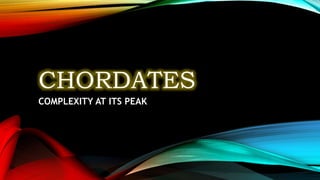
CHORDATES -- Complexity at its Peak.pptx
- 1. CHORDATES COMPLEXITY AT ITS PEAK
- 2. LOOK BACK
- 3. Who’s that Chordate? Unscramble the words below to identify who/what the image is showing.
- 7. This phylum accounts for the 52,000 species of vertebrates and several thousand species of invertebrates that live here on Earth. Together, they range from brainless filter-feeders all the way up to people, like Scarlett Johansson.
- 8. Like all other organisms, chordates have basic characteristics that set them apart from the rest of the animal kingdom. Some of these traits can be observed in an entire lifespan of some chordates, while some chordates only exhibit these traits at a certain stage in their life. These traits are unique to this phylum and cannot be found in other organisms or in ancestral species.
- 9. BROTHERS – IN – ARMS FIRST ACTIVITY:
- 10. INSTRUCTIONS: 1. Create five groups with equal number of members. 2. Each group will be given an activity sheet to work with. Follow the directions indicated in the activity sheets. 3. Write the answers you have come up on the manila paper provided.
- 11. ALL FOR ONE, ONE FOR ALL: SHARED TRAITS OF CHORDATES 1. Post – anal Tail Just as the name suggests, it is a structure that extends above the anus. Most chordates utilize the tail for locomotion such as fishes, and to maintain balance such as kangaroos. In humans, the post-anal tail disappears during embryonic development and becomes a structure called the coccyx or tail bone.
- 12. 2. Pharyngeal Slits These are a set of slits, usually around 4 to 7 slits, sometimes more, that are present to all chordates at a certain stage in their life cycle. In simpler chordates, the slits are present in their entire lifespan but in complex chordates, the slits usually disappear and theoretically develop into other body parts such as the jaw.
- 13. 3. Notochord The notochord is the reason how chordates got their name. It is a structure comprised of cartilage and is present in all chordates at a certain stage in their lifespan. Found at the center of embryos, this organ is the foundation for all other internal structures in a chordate. In vertebrates, the notochord becomes the disk that supports the backbone.
- 14. 4. Nerve Chord The nerve cord is made of nerve fibers. This structure is found stomach- side, meaning it is located behind the digestive track. Lower class chordates retain the basic nerve cord structure but in complex chordates, the nerve cord develops into the Central Nervous System.
- 15. The most diverse among the subphyla. These chordates are characterized by having an endoskeleton with a central vertebrae as the foundation. The skeleton of these creatures can either be cartilaginous or calcified(bony). It is from this subphylum that humans and other land-dwelling animals belong to.
- 16. PARK RANGER!!! DIRECTIONS ARE IN THE ANSWER SHEET. SECOND ACTIVITY:
- 17. NAME: CARABAO CAN BE FOUND LOCALLY
- 18. NAME: SHARK CANNOT BE FOUND LOCALLY
- 19. NAME: TURTLE/”PAWIKAN” CAN BE FOUND LOCALLY
- 20. NAME: LION CANNOT BE FOUND LOCALLY
- 21. NAME: ELEPHANT CANNOT BE FOUND LOCALLY
- 22. A STEP ON LAND: THE FOUR CLASSES OF VERTEBRATES AMPHIBIA They are considered as the first group of organisms that were able to live on land. They are ectothermic which means they absorb external heat to maintain body temperature. They start off as tadpoles that live in water and become adults that live on land. They still need water though because some amphibians have moist skin.
- 23. REPTILIA This class of vertebrates were the first to develop eggs coated in a hard shell that are able to develop on dry land. They are ectothermic just like amphibians, but have dry scaly skin that prevent dehydration. This is where we find our dinosaurs, snakes, turtles, and lizards.
- 24. AVES (Birds) They are endothermic organisms, meaning they can maintain their body temperature via homeostasis. They are covered in feathers and have a four-chambered heart unlike reptiles and amphibians. This class evolved from Archosaurs, the oldest known species of reptiles that became extinct 65 million years ago. Their closest living relatives are crocodiles, alligators.
- 25. MAMMALIA This class of vertebrates is the most complex species on Earth. They are endothermic just like birds but are covered in fur, and have special glands that produce milk called the mammary glands, hence the name. Most species of mammals give birth to live offspring. These offspring can either develop in eggs, in specialized pouches, or inside the womb of the mother.
- 27. POP QUIZ!!! Directions: In a ¼ piece of paper, answer the items below by writing the letter of the correct answer.
- 28. 1. Which of the following characteristics is the reason we get the name chordates? a. Notochord b. Pharyngeal Slits c. Post-anal Tail d. Nerve Cord 2. Which of the following classes of chordates can produce milk? a. Aves b. Reptilia c. Mammalia d. Amphibia 3. Which of the following organisms are the closest relatives of birds? a. Crocodiles b. Bats c. Frogs d. Fishes 4. Among the following traits or chordates, the one that develops into the jaw is the… a. Notochord b. Post-anal Tail c. Pharyngeal Slits d. Nerve Cord 5. What class of chordates were the first to live on land? a. Mammalia b. Aves c. Amphibia d. Reptilia
- 30. CARPE DIEM